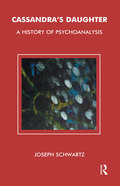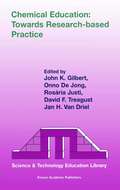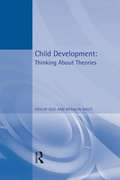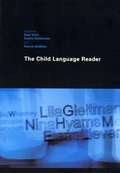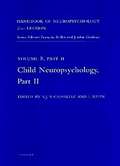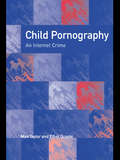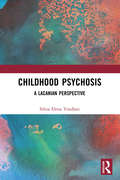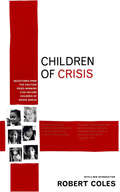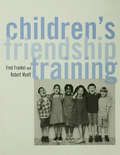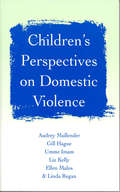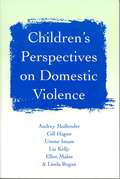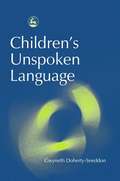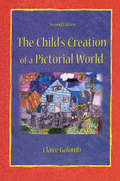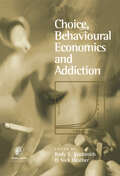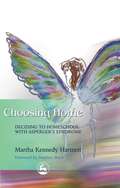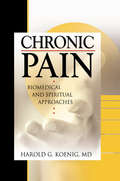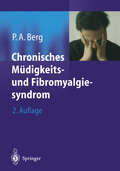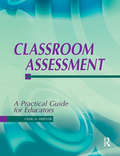- Table View
- List View
Cassandra's Daughter: A History of Psychoanalysis
by Joseph SchwartzThis work presents a complete history of psychoanalysis from its origins in 19th-century medical science to the end of the 20th century. The origins of psychoanalysis as well as the more immediate influences on Freud are explored, as is the way the discipline he founded has developed and changed.Joseph Schwartz first lays out the late Victorian approaches to mental illness and health and explains the context in which Freud's revolution took place. He traces the evolution of Freud's own thought, then shows how and why the rifts and shifts in the analytic community occurred. He then focuses on Freud's colleagues, rivals, successors and detractors - Jung, Adler, Sullivan, Melanie Klein, Erich Fromm to name a few. For once we see how the different schools and interpretations fit together - how they grew in response to each other, and what separate contributions each pioneer made over the last hundred years to create an effective understanding of the world of human subjective experience.
Chemical Education: Towards Research-based Practice (Contemporary Trends and Issues in Science Education #17)
by Jan H. Driel David F. Treagust RosáriaJusti OnnoJong John K. GilbertChemical education is essential to everybody because it deals with ideas that play major roles in personal, social, and economic decisions. This book is based on three principles: that all aspects of chemical education should be associated with research; that the development of opportunities for chemical education should be both a continuous process and be linked to research; and that the professional development of all those associated with chemical education should make extensive and diverse use of that research. It is intended for: pre-service and practising chemistry teachers and lecturers; chemistry teacher educators; chemical education researchers; the designers and managers of formal chemical curricula; informal chemical educators; authors of textbooks and curriculum support materials; practising chemists and chemical technologists. It addresses: the relation between chemistry and chemical education; curricula for chemical education; teaching and learning about chemical compounds and chemical change; the development of teachers; the development of chemical education as a field of enquiry. This is mainly done in respect of the full range of formal education contexts (schools, universities, vocational colleges) but also in respect of informal education contexts (books, science centres and museums).
Child Development: Thinking About Theories Texts in Developmental Psychology
by Phillip Slee Rosalyn ShuteThis is one of the few books to critical examine both modern and postmodern contributions to theoretical development in child and adolescent psychology. It has been specially written to take into account the findings from a focus group of honors psychology students in order to include pedagogical features such as an overview of theories linking the various schools of thought, ideas for further study, and links to selected web sites; as well as the latest developments in theoretical thinking. 9781444144635 9786613059857 9780340808177
Child Development: Thinking About Theories Texts in Developmental Psychology (PDF)
by Phillip Slee Rosalyn ShuteThis is one of the few books to critical examine both modern and postmodern contributions to theoretical development in child and adolescent psychology. It has been specially written to take into account the findings from a focus group of honors psychology students in order to include pedagogical features such as an overview of theories linking the various schools of thought, ideas for further study, and links to selected web sites; as well as the latest developments in theoretical thinking. 9781444144635 9786613059857 9780340808177
The Child Language Reader (PDF)
by Kate Trott Sushie Dobbinson Patrick GriffithsThe Child Language Reader provides an introduction to the most important research in child language acquisition and development. Including extensive editorial introductions, which explain key background, assumptions and terminology, and organized into thematic sections, it brings the reader into direct contact with original research, in a supported and guided environment. Features include: *articles written by a range of international authors, including classics by influential figures *coverage of a number of language development areas, including phonology, semantics, sociolinguistics, methodology and bilingualism *a substantial section on methodology, offering practical insight into the design of child language research *an appendix on statistical analysis *a new piece by Brian Richards and David Malvern. Covering a range of different theoretical standpoints, The Child Language Reader offers a comprehensive overview of the field, and is a definitive resource for anyone with an interest in child language.
Child Neuropsychology (Handbook Of Neuropsychology Ser. #8 (PDF))
by S. J. SegalowitzVolume 8 consists of Parts I and II. Part I considers theoretical perspectives in bridging developmental neuroscience with child psychology, with the role of neuroscience furthering our understanding of the child?s mental development, and a separate chapter outlines the importance of plasticity in this growth. Chapters also cover methodological issues arising from epidemiological perspectives and from psychometric concepts and issues. Methods for measuring biological brain function and structure and their particular application to child neuropsychological disorders are covered next, including ERP, PET, SPECT, MRI and fMRI technologies. Included is a chapter devoted to childhood seizure disorders. Separate chapters follow on neuropsychological assessment in infancy, in the preschool child, and in school-aged children. Following this are presentations on the development of motor control, including handedness, and somatosensory perception. Part II begins with chapters on visual development and on development in visually impaired children, followed by chapters on cognitive development in deaf children and on central auditory functions and their evaluation. This is followed by chapters on early language development and its neural correlates, developmental language disorders, and on acquired aphasia in childhood. Two chapters on dyslexia and another on dyscalculia follow. Next is a chapter on disorders of memory with a special focus on temporal lobe disease and autism, one on attention disorders, and one on executive functions in normal and abnormal development. Following this are chapters on the development of emotional regulation and on mechanisms and influences on addiction in children and adolescents. Final chapters include one on eating disorders, and another focussing on autism spectrum disorders.
Child Pornography: An Internet Crime
by Ethel Quayle Max TaylorChild pornography, particularly that available via the Internet, has become a cause of huge social concern in recent years. This book examines the reality behind the often hysterical media coverage of the topic. Drawing on extensive new research findings, it examines how child pornography is used on the Internet and the social context in which such use occurs, and develops a model of offending behaviour to better help understand and deal with the processes of offending. Detailed case studies and offenders' own accounts are used to illustrate the processes involved in offending and treatment.The authors argue that we need to refine our ideas of offending, and that while severe deterrents need to be associated with possession of child pornography, a better understanding is needed of the links between possession and committing a contact offence. Only by improving our understanding of this complex and very controversial topic can we hope to deal effectively with offenders and with their child victims. This is a book which will become an essential read for anyone involved with offenders or victims from a psychological, judicial or social background.
Child Pornography: An Internet Crime
by Ethel Quayle Max TaylorChild pornography, particularly that available via the Internet, has become a cause of huge social concern in recent years. This book examines the reality behind the often hysterical media coverage of the topic. Drawing on extensive new research findings, it examines how child pornography is used on the Internet and the social context in which such use occurs, and develops a model of offending behaviour to better help understand and deal with the processes of offending. Detailed case studies and offenders' own accounts are used to illustrate the processes involved in offending and treatment.The authors argue that we need to refine our ideas of offending, and that while severe deterrents need to be associated with possession of child pornography, a better understanding is needed of the links between possession and committing a contact offence. Only by improving our understanding of this complex and very controversial topic can we hope to deal effectively with offenders and with their child victims. This is a book which will become an essential read for anyone involved with offenders or victims from a psychological, judicial or social background.
Childhood Psychosis: A Lacanian Perspective
by Silvia Elena TendlarzThis book, focusing on the work of Jacques Lacan, examines psychosis in children, without ignoring the study of neurosis in childhood and concentrates on autism as produced by psychic disorders, by the symbolic failure that brings about the inclusion of the subject into the psychotic structure.
Childhood Psychosis: A Lacanian Perspective
by Silvia Elena TendlarzThis book, focusing on the work of Jacques Lacan, examines psychosis in children, without ignoring the study of neurosis in childhood and concentrates on autism as produced by psychic disorders, by the symbolic failure that brings about the inclusion of the subject into the psychotic structure.
Children of Crisis
by Robert ColesIn the 1950s Robert Coles began studying, living among, and, above all, listening to American children. The results of his efforts -- revealed in five volumes published between 1967 and 1977 -- constitute one of the most searching and vigorous social studies ever undertaken by one person in the United States. Here, heard often in their own voices, are America's "children of crisis": African American children caught in the throes of the South's racial integration; The children of impoverished migrant workers in Appalachia; Children whose families were transformed by the migration from South to North, from rural to urban communities; Latino, Native American, and Eskimo children in the poorest communities of the American West; The children of America's wealthiest families confronting the burden of their own privilege. This volume restores to print a masterwork of psychological and sociological inquiry -- a book that, in its focus on how children learn and develop in the face of rapid change and social upheaval, speaks directly and pointedly to our own times.
Children's Friendship Training
by Fred D. Frankel Robert J. MyattFirst published in 2003. Routledge is an imprint of Taylor & Francis, an informa company.
Children's Friendship Training
by Fred D. Frankel Robert J. MyattFirst published in 2003. Routledge is an imprint of Taylor & Francis, an informa company.
Children's Perspectives on Domestic Violence
by Gill Hague Linda Regan Ms Ellen Malos Ms Liz Kelly Ms Umme F Imam Professor Audrey Mullender`The research methodology and the problems encountered when studying a subject such as domestic violence, coupled with the ethical problems of researching with children, are discussed at length in the book. This gives a good insight into the intricacies of conducting such a research study. The research looked not only at children who were known to have direct contact with domestic violence, but also what children in general thought and felt about domestic violence. The presentation of the findings, both in tabular and narrative form, was well presented' - Accident and Emergency Nursing Journal `This book offers accessible and interesting reading. It is well written as one would expect from these authors.... There are a lot of pointers for the way forward in terms of both policy and practice. This is likely to become a seminal text' - Research Policy and Planning 'This is a useful and challenging read for all of us who seek to work effectively and ethically in this complex area of practice' - Professional Social Work `Just looking at the authors of this book tells the reader that they are about to embark on a pioneering piece of academic research... a comprehensive and authoritative piece of work' - Domestic Abuse Quarterly `A vital tool for all those working with children' - ChildRight 'Written in a lucid style and is easy to read… it is essential reading for all students in social work undergraduate courses and also in post-qualifying courses on child welfare and protection. In addition professionals who are directly working in the area of child protection, schools and criminal justice settings would find this book informative and useful in understanding what children and young people want, and need, in relation to living in domestic violence situations' - Child and Family Social Work 'This book is powerfully written and is essential reading for professional working with and supporting abused women and their children. Its groundbreaking focus on children's experiences adds much to our understanding of the complexities of domestic violence' - Journal of Family Studies 'A treasure-chest of rich, diverse and powerful extracts from children and young people… in particular the material presented on different coping strategies used by children who have experienced domestic violence is an important contribution to an area about which very little is known' - Adoption and Fostering Journal How do children who live with domestic violence cope? How do they make sense of their experiences? Do they receive the right sort of help from formal and informal sources? Drawing on the newest research designed to hear the voices of children and young people, this important book examines children's experiences and perspectives on living with domestic violence. The authors explore: - the effect of domestic violence on children - what children say would help them most in coping with domestic violence - the advice children would offer other children who find themselves in similar circumstances, their mothers and the helping professions. This accessible book written for students, their teachers, researchers and all those working with children - across social work, health, child psychology and psychiatry, the law and education - will provide a vital insight into children's own perspectives on domestic violence.
Children's Perspectives on Domestic Violence (PDF)
by Linda Regan Gill Hague Ms Ellen Malos Ms Liz Kelly Ms Umme F Imam Professor Audrey Mullender`The research methodology and the problems encountered when studying a subject such as domestic violence, coupled with the ethical problems of researching with children, are discussed at length in the book. This gives a good insight into the intricacies of conducting such a research study. The research looked not only at children who were known to have direct contact with domestic violence, but also what children in general thought and felt about domestic violence. The presentation of the findings, both in tabular and narrative form, was well presented' - Accident and Emergency Nursing Journal `This book offers accessible and interesting reading. It is well written as one would expect from these authors. . . . There are a lot of pointers for the way forward in terms of both policy and practice. This is likely to become a seminal text' - Research Policy and Planning 'This is a useful and challenging read for all of us who seek to work effectively and ethically in this complex area of practice' - Professional Social Work `Just looking at the authors of this book tells the reader that they are about to embark on a pioneering piece of academic research. . . a comprehensive and authoritative piece of work' - Domestic Abuse Quarterly `A vital tool for all those working with children' - ChildRight 'Written in a lucid style and is easy to read. . . it is essential reading for all students in social work undergraduate courses and also in post-qualifying courses on child welfare and protection. In addition professionals who are directly working in the area of child protection, schools and criminal justice settings would find this book informative and useful in understanding what children and young people want, and need, in relation to living in domestic violence situations' - Child and Family Social Work 'This book is powerfully written and is essential reading for professional working with and supporting abused women and their children. Its groundbreaking focus on children's experiences adds much to our understanding of the complexities of domestic violence' - Journal of Family Studies 'A treasure-chest of rich, diverse and powerful extracts from children and young people. . . in particular the material presented on different coping strategies used by children who have experienced domestic violence is an important contribution to an area about which very little is known' - Adoption and Fostering Journal How do children who live with domestic violence cope? How do they make sense of their experiences? Do they receive the right sort of help from formal and informal sources? Drawing on the newest research designed to hear the voices of children and young people, this important book examines children's experiences and perspectives on living with domestic violence. The authors explore: - the effect of domestic violence on children - what children say would help them most in coping with domestic violence - the advice children would offer other children who find themselves in similar circumstances, their mothers and the helping professions. This accessible book written for students, their teachers, researchers and all those working with children - across social work, health, child psychology and psychiatry, the law and education - will provide a vital insight into children's own perspectives on domestic violence.
Children's Unspoken Language
by Gwyneth Doherty-SneddonGwyneth Doherty-Sneddon, a developmental psychologist and the mother of two young children, demonstrates the way in which a young child's developing personality and intelligence is revealed through non-verbal communication. She shows how parents and other adults have the potential to facilitate a child's social and intellectual growth through acknowledging and responding to this unspoken language. Taking an in-depth look at four of the channels of non-verbal communication - hand gesture, facial expression, eye gaze and touch - this accessible text follows the development of young children from birth to late primary school age. Using jargon-free language Children's Unspoken Language is invaluable reading for parents and professionals alike.
Children's Unspoken Language (PDF)
by Gwyneth Doherty-SneddonGwyneth Doherty-Sneddon, a developmental psychologist and the mother of two young children, demonstrates the way in which a young child's developing personality and intelligence is revealed through non-verbal communication. She shows how parents and other adults have the potential to facilitate a child's social and intellectual growth through acknowledging and responding to this unspoken language. Taking an in-depth look at four of the channels of non-verbal communication - hand gesture, facial expression, eye gaze and touch - this accessible text follows the development of young children from birth to late primary school age. Using jargon-free language Children's Unspoken Language is invaluable reading for parents and professionals alike.
The Child's Creation of A Pictorial World
by Claire GolombThis book places child art within the broader context of children's creative intelligence and intrinsic motivation to invent a pictorial world. It examines the development of drawing and painting from several currently dominant theoretical perspectives. This is followed by an extensive examination of empirical data on the art work of children who are ordinary, talented, emotionally disturbed, and atypically developed due to mental disability or autism. The Child's Creation of a Pictorial World uses a developmental framework that combines theoretical sophistication with rigorous empirical investigations into the mental processes that underlie the child's drawings. It delineates the evolution of forms, the pictorial differentiation of figures and their spatial relations, the role of color in narrative descriptions, and its expressive function. Artistic development across all these dimensions is seen as a meaningful mental activity that serves cognitive, affective, and aesthetic functions.
The Child's Creation of A Pictorial World
by Claire GolombThis book places child art within the broader context of children's creative intelligence and intrinsic motivation to invent a pictorial world. It examines the development of drawing and painting from several currently dominant theoretical perspectives. This is followed by an extensive examination of empirical data on the art work of children who are ordinary, talented, emotionally disturbed, and atypically developed due to mental disability or autism. The Child's Creation of a Pictorial World uses a developmental framework that combines theoretical sophistication with rigorous empirical investigations into the mental processes that underlie the child's drawings. It delineates the evolution of forms, the pictorial differentiation of figures and their spatial relations, the role of color in narrative descriptions, and its expressive function. Artistic development across all these dimensions is seen as a meaningful mental activity that serves cognitive, affective, and aesthetic functions.
Choice, Behavioural Economics and Addiction
by Nick Heather Rudy E. VuchinichChoice, Behavioural Economics and Addiction is about the theory, data, and applied implications of choice-based models of substance use and addiction. The distinction between substance use and addiction is important, because many individuals use substances but are not also addicted to them. The behavioural economic perspective has made contributions to the analysis of both of these phenomena and, while the major focus of the book is on theories of addiction, it is necessary also to consider the behavioural economic account of substance use in order to place the theories in their proper context and provide full coverage of the contribution of behavioural economics to this field of study. The book discusses the four major theories of addiction that have been developed in the area of economic science/behavioural economics. They are:• hyperbolic discounting• melioration• relative addiction• rational addiction The main objective of the book is to popularise these ideas among addiction researchers, academics and practitioners. The specific aims are to articulate the shared and distinctive elements of these four theories, to present and discuss the latest empirical work on substance abuse and addiction that is being conducted in this area, and to articulate a range of applied implications of this body of work for clinical, public health and public policy initiatives. The book is based on an invitation-only conference entitled, Choice, Behavioural Economics and Addiction: Theory, Evidence and Applications held at the University of Alabama at Birmingham, March 30 - April 1, 2001. The conference was attended by prominent scientists and scholars, representing a range of disciplines concerned with theories of addiction and their consequences for policy and practice. The papers in the book are based on the papers given at the above conference, together with commentaries by distinguished experts and, in many cases, replies to these comments by the presenters.
Choosing Home: Deciding to Homeschool with Asperger's Syndrome (PDF)
by Martha Hartnett Stephen ShoreMartha Kennedy Hartnett is the mother of a child with Asperger's Syndrome who made the courageous choice to homeschool. Emerging from the author's personal experience, this book is a step by step account of successful home education. Choosing Home will take you into the homes of Asperger families as they journey from survival of the playground bully to making it work at home. Hartnett embraces those pertinent questions raised by parents: Will I be limiting my child's emotional and social development? How will I know if my teaching is good enough? What if I can't cope? These questions and many more are answered in this touching and insightful narrative. This is a book of hope and encouragement to all parents with an interest in homeschooling.
Chronic Pain: Biomedical and Spiritual Approaches
by Harold G KoenigHelp your clients achieve victory over chronic pain and lead more fulfilling lives!This insightful and informative book will help you deliver better pain management services to the people you care for. Incorporating biomedical, surgical, psychological, social, and spiritual perspectives, it provides vital, up-to-date information about how to reduce physical pain and explores techniques for improving people&’s ability to cope with it. Helpful tables provide easy access to information on medications for pain and managing side effects.Chronic Pain: Biomedical and Spiritual Approaches is filled with resources for the person in pain and for the health or religious professionals working to help them. It gives you very specific suggestions on how to manage chronic pain, including detailed information about medications, alternative therapies, psychological treatments, and spiritual strategies for pain management. The book is completed by two thoughtful appendixes: one examining pain medications and ways to manage their side effects and the other providing scriptural passages that can comfort those in pain.In addition to his experiences treating patients with chronic pain, the author suffers from chronic pain and disability himself. In this very personal book, he explores ways to help people coping with: low back pain fibromyalgia rheumatologic pain headaches the pain of multiple sclerosis other types of chronic unrelenting painChronic Pain: Biomedical and Spiritual Approaches can help people in pain and their families by showing them how to lead satisfying, joy-filled lives--whether their pain goes away or not. It is an essential reference book for everyone who works with pain sufferers as well as patients and their families!
Chronic Pain: Biomedical and Spiritual Approaches
by Harold G KoenigHelp your clients achieve victory over chronic pain and lead more fulfilling lives!This insightful and informative book will help you deliver better pain management services to the people you care for. Incorporating biomedical, surgical, psychological, social, and spiritual perspectives, it provides vital, up-to-date information about how to reduce physical pain and explores techniques for improving people&’s ability to cope with it. Helpful tables provide easy access to information on medications for pain and managing side effects.Chronic Pain: Biomedical and Spiritual Approaches is filled with resources for the person in pain and for the health or religious professionals working to help them. It gives you very specific suggestions on how to manage chronic pain, including detailed information about medications, alternative therapies, psychological treatments, and spiritual strategies for pain management. The book is completed by two thoughtful appendixes: one examining pain medications and ways to manage their side effects and the other providing scriptural passages that can comfort those in pain.In addition to his experiences treating patients with chronic pain, the author suffers from chronic pain and disability himself. In this very personal book, he explores ways to help people coping with: low back pain fibromyalgia rheumatologic pain headaches the pain of multiple sclerosis other types of chronic unrelenting painChronic Pain: Biomedical and Spiritual Approaches can help people in pain and their families by showing them how to lead satisfying, joy-filled lives--whether their pain goes away or not. It is an essential reference book for everyone who works with pain sufferers as well as patients and their families!
Classroom Assessment: A Practical Guide for Educators
by Dr Craig Mertler• Provides detailed information on· the functions of assessment;· how to construct, administer, and interpret the results of teacher-developed assessment techniques; and· how to interpret the results of externally developed instruments such as standardized tests.• Both traditional and newer, alternative assessment techniques are covered.• Advantages and disadvantages of each assessment technique are discussed.• A companion website helps both instructors and students obtain additional information on topics of special interest to them.• Numerous examples of the principles and procedures make it easy for students to understand the material.• The highly practical nature of this book stems from the focus on how assessment intertwines with other everyday activities in classrooms.• Measurement theory and computational procedures that are unlikely to be used by classroom teachers are de-emphasized, producing a textbook that provides comprehensive coverage without being unnecessarily technical.
